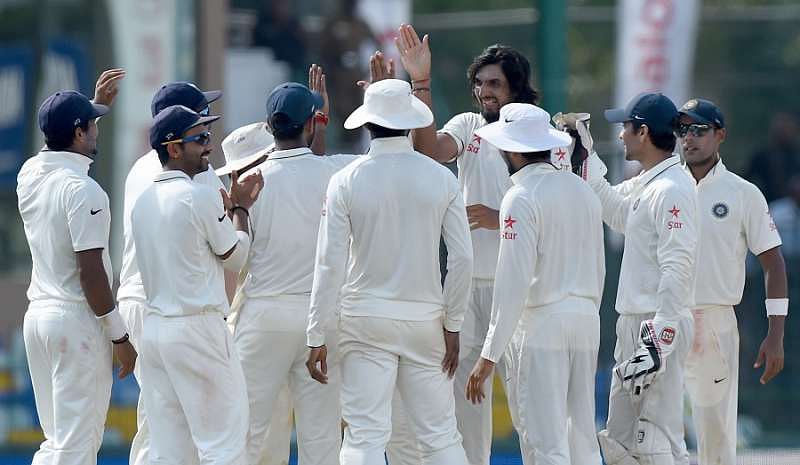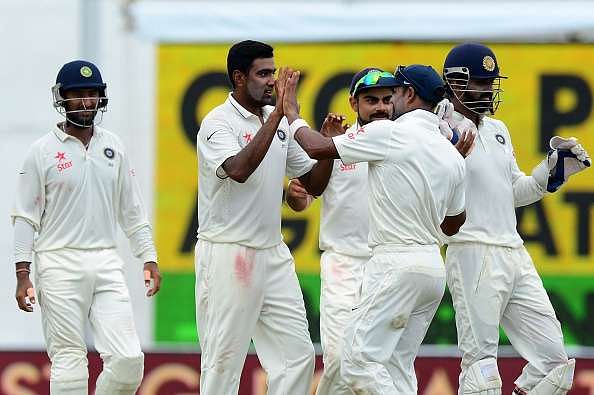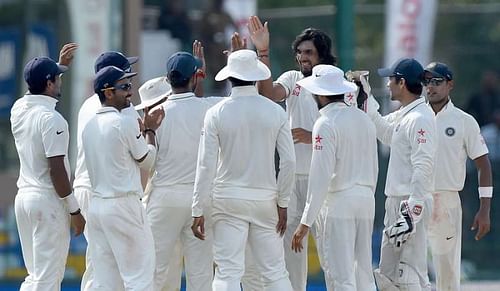
Why the bowlers are the real reason behind India’s Test resurgence
India as a cricketing nation is known to produce batting greats. From Sunil Gavaskar to Sachin Tendulkar to Virat Kohli, India keep producing these run machines generation after generation.
There have been the odd bowling greats like Kapil Dev, Anil Kumble or Harbhajan Singh. But how often have oppositions looked at the Indian bowling line-up and wished to have one like that?
Not many. The Indian Test batting line-up in the mid-2000s was adored and looked up to.
Sehwag, Dravid, Tendulkar, Laxman, Ganguly, Dhoni.
Phew! Beat that. Forget the Aussie line-ups in the early 2000s. This is the real deal. Here were seven astonishing batsmen that opposition bowlers would look at and think, “That’s a long day in the field”.
But the bowling? Rarely have opposition batsmen not licked their lips seeing the Indian bowling line-up. All the more so, if conditions were outside the sub-continent. But times have changed. With tremendous focus on fitness in recent times, Indians have athletic fielders and strong fast bowlers who can push and cross the 150kmph barrier.
With a tactful world-class spinner in Ravichandran Ashwin and reliable allies in Jadeja and Mishra, India have a strong bowling attack and statistics show the bowlers have turned around India’s fortunes in the longest form of the game.
Wondering how?
Let us take a look into the beginning of the change in India’s luck in Tests in recent times. It starts after the tour Down Under in 2014/15. Virat Kohli is now at the helm and Ravi Shastri, someone who backs the young captain strongly, aids him, acting as Team Director. The duo publically declared that winning test matches require you to take 20 wickets and hence, playing five bowlers is the “way forward”.
He was quick to add that the strategy was “not set in stone” but they would employ it in most Tests as it will not only make their batsmen more responsible but also add teeth to the attack. If Jadeja or Harbhajan Singh played on turning tracks as the fifth bowler, in seaming conditions it was Stuart Binny.
Before the start of the South African series in India, Kohli had led India in six matches, of which, he fielded five bowlers in four of them, including five in all three Tests in Sri Lanka. India have recorded series wins against Sri Lanka, South Africa and West Indies and drew a rain-marred series in Bangladesh.
They are yet to lose a series with Kohli leading. The strategy might not have been the century-long-sought-after-secret-formula, but it was important in its own way.
Let us take a look at India’s bowling averages in the last 8 Test series they have played in:
SERIES | MATCHES | WON | LOST | DRAW | BOWLING AVERAGE | WINNER |
India in South Africa 2013/14 | 2 | 0 | 1 | 1 | 46.40 | South Africa |
India in New Zealand 2013/14 | 2 | 0 | 1 | 1 | 38.94 | New Zealand |
India in England 2014 | 5 | 1 | 3 | 1 | 44.41 | England |
India in Australia 2014/15 | 4 | 0 | 2 | 2 | 51.88 | Australia |
India in Bangladesh 2015 | 1 | 0 | 0 | 1 | 27.90 | Draw |
India in Sri Lanka 2015 | 3 | 2 | 1 | 0 | 24.31 | India |
South Africa in India 2015/16 | 4 | 3 | 0 | 1 | 14.78 | India |
India in West Indies 2016 | 4 | 2 | 0 | 2 | 25.05 | India |
As evident from above statistics, since the Australian tour Down Under, India’s bowling averages have gone down considerably. A look at the batting averages in the last 4 series where India’s Test success have taken root reveals that batting has not been as much as a major contributor as bowling.
SERIES | MATCHES | WON | LOST | DRAW | BATTING AVERAGES | WINNER |
India in Bangladesh 2015 | 1 | 0 | 0 | 1 | 77.00 | Draw |
India in Sri Lanka 2015 | 3 | 2 | 1 | 0 | 30.87 | India |
South Africa in India 2015/16 | 4 | 3 | 0 | 1 | 26.72 | India |
India in West Indies 2016 | 4 | 2 | 0 | 2 | 48.11 | India |
While it is to be considered that the former four tours were all outside the subcontinent and three of the latter four were in sub-continental conditions, there is a considerable change in the fast bowler’s averages as well.
India’s main fast bowlers during the period after Kohli took over, Ishant Sharma, Mohammad Shami and Bhuvaneshwar Kumar all find places in India’s top 5 wicket takers since June 2013. Ashwin is at the top of the list and Jadeja is the other spinner.

While Ishant has taken 65 wickets in 21 matches, Shami and Bhuvaneshwar have 58 and 29 in 16 and 10 matches respectively. Ishant Sharma is the only one among the three fast bowlers to feature in a series prior to 2013 and his average has dropped considerably in the next three years as has his wicket taking ability.
Ashwin has improved by leaps and bounds and his average of 22.16 post-2013, compared to his earlier average of 28.53 is evidence that he has enjoyed the extra support from other bowlers.
Ravindra Jadeja is another bowler whose figures have improved much in the last few Tests.
Since making a comeback in the series against South Africa at home, Jadeja has taken 26 wickets in 5 Tests with a best of 5/21 against South Africa in Mohali. Ashwin has taken as many as 6 five-wicket hauls in the last eight Tests.
The below table shows a look into how each of India’s main bowlers have fared in matches since 2013 June.
PLAYER | MATCHES | WICKETS | AVERAGE |
Ravichandran Ashwin | 20 | 101 | 22.16 |
Ishant Sharma | 21 | 65 | 33.89 |
Mohammed Shami | 16 | 58 | 34.18 |
Ravindra Jadeja | 12 | 44 | 25.61 |
Bhuvaneshwar Kumar | 10 | 29 | 28.79 |
Amit Mishra | 7 | 28 | 20.64 |
What do the numbers tell us?
The stats clearly show that the Indian bowlers have enjoyed a good phase since 2013. Their performances have meant that India could afford a slump in the form of their batsmen. A look at the series against South Africa in home clears up matters a bit more.
India won the series 3-0 but their batsmen averaged a mere 26.72 in the series. Rahane scored the only century from either side and with an average of 53.20, was the only player to average above 35 from India. Despite a poor batting performance, India swept the Freedom Series 3-0 and that shows the work the bowling unit has done.
Another interesting stat shows that India are yet to concede more than 400 in an innings since the Australian tour in 2014/15. The highest India have conceded is the 388 West Indies scored in Sabina Park to draw the 2nd test between the sides.
While the point that most of the surfaces India have played in since that fateful Australian tour are sub-continent-like exists, but it is worth mentioning that the victories have not come based on big scores by the batsmen.
More often than not, it was the bowlers that produced match-winning performances. Led by Ashwin, the Indian bowling unit have formed a formidable pack that hunts from all corners. With a back-up fifth bowler available in most games, India can bank on him to provide the breakthroughs.
That said, the player who fills in as the fifth bowler, be it Ashwin, Jadeja or Binny, needs to ensure that they can pack a punch with the bat too. If this does not happen, India might have a long tail not so worth boasting about.
India are set to play New Zealand and England at home in the coming months and the bowling unit, especially the spinners, will be licking their lips to bowl at the Kiwis and English batsmen.
The real test of this bowling unit will come in tours outside the sub-continent and India will look up to their pace bowlers to take command and lead the bowling unit with Ashwin playing a holding role.
The debate of whether the bowling unit is the real reason behind India’s Test resurgence will keep popping up until that happens.
